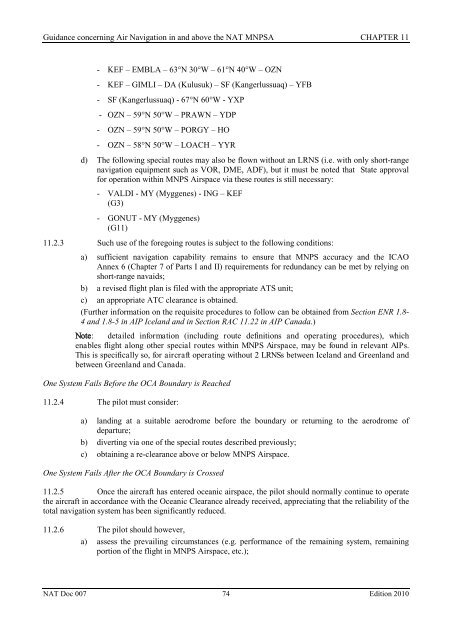World Air Ops | NAT | Doc 007 MNPS Guidance
World Air Ops | NAT | Doc 007 MNPS Guidance
World Air Ops | NAT | Doc 007 MNPS Guidance
You also want an ePaper? Increase the reach of your titles
YUMPU automatically turns print PDFs into web optimized ePapers that Google loves.
<strong>Guidance</strong> concerning <strong>Air</strong> Navigation in and above the <strong>NAT</strong> <strong>MNPS</strong>A CHAPTER 11- KEF – EMBLA – 63°N 30°W – 61°N 40°W – OZN- KEF – GIMLI – DA (Kulusuk) – SF (Kangerlussuaq) – YFB- SF (Kangerlussuaq) - 67°N 60°W - YXP- OZN – 59°N 50°W – PRAWN – YDP- OZN – 59°N 50°W – PORGY – HO- OZN – 58°N 50°W – LOACH – YYRd) The following special routes may also be flown without an LRNS (i.e. with only short-rangenavigation equipment such as VOR, DME, ADF), but it must be noted that State approvalfor operation within <strong>MNPS</strong> <strong>Air</strong>space via these routes is still necessary:- VALDI - MY (Myggenes) - ING – KEF(G3)- GONUT - MY (Myggenes)(G11)11.2.3 Such use of the foregoing routes is subject to the following conditions:a) sufficient navigation capability remains to ensure that <strong>MNPS</strong> accuracy and the ICAOAnnex 6 (Chapter 7 of Parts I and II) requirements for redundancy can be met by relying onshort-range navaids;b) a revised flight plan is filed with the appropriate ATS unit;c) an appropriate ATC clearance is obtained.(Further information on the requisite procedures to follow can be obtained from Section ENR 1.8-4 and 1.8-5 in AIP Iceland and in Section RAC 11.22 in AIP Canada.)Note: detailed information (including route definitions and operating procedures), whichenables flight along other special routes within <strong>MNPS</strong> <strong>Air</strong>space, may be found in relevant AIPs.This is specifically so, for aircraft operating without 2 LRNSs between Iceland and Greenland andbetween Greenland and Canada.One System Fails Before the OCA Boundary is Reached11.2.4 The pilot must consider:a) landing at a suitable aerodrome before the boundary or returning to the aerodrome ofdeparture;b) diverting via one of the special routes described previously;c) obtaining a re-clearance above or below <strong>MNPS</strong> <strong>Air</strong>space.One System Fails After the OCA Boundary is Crossed11.2.5 Once the aircraft has entered oceanic airspace, the pilot should normally continue to operatethe aircraft in accordance with the Oceanic Clearance already received, appreciating that the reliability of thetotal navigation system has been significantly reduced.11.2.6 The pilot should however,a) assess the prevailing circumstances (e.g. performance of the remaining system, remainingportion of the flight in <strong>MNPS</strong> <strong>Air</strong>space, etc.);<strong>NAT</strong> <strong>Doc</strong> <strong>007</strong> 74 Edition 2010
















